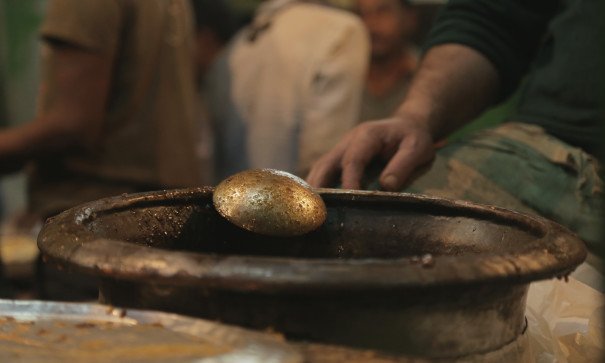
The Indian Meal That Is a National Sentiment, a Political Rebellion, and a Piece of History

The Indian Meal That Is a National Sentiment, a Political Rebellion, and a Piece of History
Nihari in Old Delhi
“South Africa, Japan, Croatia, everyone wants some of my brain!” my chef for the morning roars as he puts a big piece of brain on a plate.
“I’m Hindu,” I grin at him, meaning I shouldn’t be indulging. “You’re still here!” he roars again. I know then I have something to prove. Nihari—beef stew—is a typical dish in northern India, and to Delhi. It is one of the oldest foods of the Indian subcontinent, and one of the few eaten on both sides of the border with Pakistan. The meat is cooked for over 16 hours in a large pot and served with a layer of ghee (saturated butter) and a garnish of minced chillies, garlic, and ginger. Nihari is served with light, dry bread—khmeri roti—made in deep ovens by the hundreds. I ask if he uses tomatoes, and he chuckles at me and tells me he’d need all of Spain’s tomatoes to feed his customers.
It is 6:30 am, but my lethargy vanishes when I smell the food. People hustle into lines, and I am tutted at because of my camera, and I remember the last time I was here as a teenager. Drunk and stumbling, we had stayed up till dawn and driven across New Delhi to confirm the myth of Haji Noora Nihari, the best beef in the world. After endless snapping at each other and reckless sleeping at the wheel, we had arrived to find that stewed meat can end all hostilities. Nihari puts everyone on the same page. Drunk teenagers, nonreligious Hindus, relentless imams, and young liberal Muslims unite over plates of slow-cooked meat.
Haji Noora is a tiny shop near one of many of Delhi’s incomplete highways. As everyone waits, noses are covered to avoid the ubiquitous dust. It is a sort of pilgrimage, a struggle, and everyone stands together in silent resolve. Noora makes two batches of nihari each day. The more sought after, decadent pot goes on at noon for the next morning, cooking for 18 hours. When we arrive, the shop seems overstaffed, but once service starts, they begin to work like a well-trained army. My cheerful server is companion to a sullen, bearded old man whom they call Chacha—Delhi slang for uncle. Chacha is irate, skeptical, but I see him stifle a grin when his workers throw dough at each other and curse. There is a bond that is similar to kinship among the people who live in Old Delhi. These men live today but are anchored in the past thousand years. Chacha announces that the pot is now only half full. There is nervous shuffling from the diners on the floor.
Today, under the rule of a government slowly but steadily tending towards manic Hindu fundamentalism, nihari is symbolic of Delhi’s history. It is layered, indulgent, complex, like the hearts that beat within the city.
“That is Shahjahan’s sleeve you’re eating,” Chacha says to me, acknowledging me for the first time in two hours. I am pleased with this; Shahjahan is Indian history’s audacious bad boy and my favorite emperor. Poet, cynic, ultimate lover, Delhi often invokes Shahjahan in times of profound decadence. As I am seated on the floor, delirious, full to the brim, I feel like I have travelled in time. Deathly pollution, financial woes, all vanish for half an hour. Nihari becomes to me what it is to all Delhiites: not a meal, but a national sentiment, a political rebellion, and a piece of history, all packed into one. The pot is now empty, and I think I can see Shahjahan, sleeveless, nod at me from the porch.